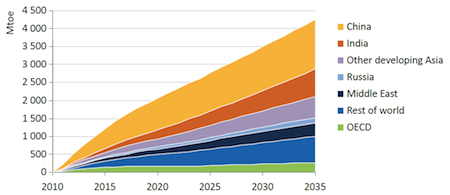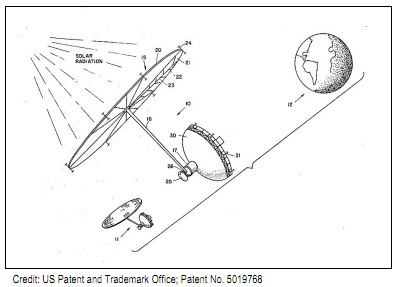Science Fiction
Dictionary
A B C D E F G H I J K L M N O P Q R S T U V W X Y Z
Space Solar Power - A Truly Limitless Source

The National Space Society presented an international assessment of space solar power. The report is presented in the context of increasing global power needs: 220 trillion kiloWatt hours per year by 2030, which is double today's power output. It will double again by 2090.
The Academy study found that the SPS concept has significant potential to meeting global
requirements for largely carbon-neutral energy during the coming century. The study found the SPS concept to be technically viable, and that it may well be possible to achieve economic viability.

(Global energy demand 2010-2035 [pdf])
The concept of the “solar power satellite” (SPS) was invented first by Dr. Peter Glaser in the late 1960s. Figure 1-2 depicts the conceptual illustration of an SPS presented in Dr. Glaser’s original patent on the concept, granted on 25 December 1973.The SPS concept can be regarded as quite elegant: a large platform, positioned in space in a high Earth orbit continuously collects and converts solar energy into electricity. This power is then used to drive a wireless power transmission (WPT) system that transmits the solar energy to receivers on Earth. Because of its immunity to nighttime, to weather or to the changing seasons, the SPS concept has the potential to achieve much greater energy-efficiency than ground based solar power systems.
Since its invention, there have been numerous studies and technology projects conducted by various government agencies, companies and universities that have been focused on the goal of the Solar Power Satellite.

(Illustration of the SPS Concept from the 1973 Patent [pdf])
The 250 page study's findings can be summarized as follows:
- Fundamentally new energy technologies clearly appear to be needed during the coming decades under all examined scenarios – both to support continued (and sustainable) global economic growth, and for reasons of environmental/climate concerns. Solar energy from space appears to be a promising candidate that can contribute to address these challenges.
- Solar Power Satellites appear to be technically feasible as soon as the coming 10-20 years using technologies existing now in the laboratory that could be developed / demonstrated (depending on the systems concept details).
- Economically viable Solar Power Satellites appear achievable during the next 1-3 decades, but more information is needed concerning both the details of potential system costs and the details of markets to be served.
- An in-depth end-to-end systems analysis of SSP/SPS is necessary to understand more fully the interactions among various systems / technologies for different concepts and markets; however, no such study has been performed since the conclusion of NASA’s Fresh Look Study in 1997.
- Low-cost Earth-to-orbit transportation is an enabling capability to the economic viability of space solar power for commercial baseload power markets.
- Systems studies are not enough. Technology Flight Experiments (TFEs) to test critical technology elements and Technology Flight Demonstrations (TFD) that validate SPS systems concepts to a high level of maturity appear to be essential in order to build confidence.
- The SPS concept is sufficiently transformational and entails enough technical uncertainties such that major systems level in-space demonstrations will be necessary to establish technical feasibility, engineering characteristics and economical viability before any organization is likely to proceed with full-scale development.
Although Dr. Peter Glaser is credited with inventing the basic concept, it is nevertheless true that science fiction authors had been popularizing the idea for at least a generation.
In his 1931 story Power Planet, Murray Leinster detailed the idea of a power planet, a very large satellite used to gather solar energy and beam it back to Earth:
The Power Planet, of course, is that vast man-made disk of metal set spinning about the sun to supply the Earth with power. Everybody learns in his grammar-school textbooks of its construction just beyond the Moon and of its maneuvering to its present orbit by a vast expenditure of rocket fuel.Only forty million miles from the sun's surface, its sunward side is raised nearly to red heat by the blazing radiation. And the shadow side, naturally, is down to the utter cold of space. There is a temperature drop of nearly seven hundred degrees between the two sides, and Williamson cells turn that heat-difference into electric current, with an efficiency of 99 percent. Then the big Dugald tubes - they are twenty feet long on the Power Planet - transform it into the beam which is focused on the Earth and delivers something over a billion horsepower to the various receivers that have been erected.
(Read more about Leinster's Power Planet)
Fans of Golden Age sf also recall with fondness the Near-Space Solar Energy Collectors from Olaf Stapledon's 1937 novel Star Maker and the Solar Energy Beam from Clifford Simak's 1941 story Masquerade.
From Space Solar Power - THE FIRST INTERNATIONAL ASSESSMENT OF SPACE SOLAR POWER: OPPORTUNITIES, ISSUES AND POTENTIAL PATHWAYS FORWARD via Kurzweil AI.
Scroll down for more stories in the same category. (Story submitted 11/28/2011)
Follow this kind of news @Technovelgy.| Email | RSS | Blog It | Stumble | del.icio.us | Digg | Reddit |
Would
you like to contribute a story tip?
It's easy:
Get the URL of the story, and the related sf author, and add
it here.
Comment/Join discussion ( 0 )
Related News Stories - (" Space Tech ")
Will Space Stations Have Large Interior Spaces Again?
'They filed clumsily into the battleroom, like children in a swimming pool for the first time, clinging to the handholds along the side.' - Orson Scott Card, 1985.
Reflect Orbital Offers 'Sunlight on Demand' And Light Pollution
'I don't have to tell you about the seven two-mile-diameter orbital mirrors...'
Chrysalis Generation Ship to Alpha Centauri
'This was their world, their planet —
this swift-traveling, yet seemingly moveless vessel.' - Nat Schachner, 1934
The First Space Warship For Space Force
'Each of the electrical ships carried about twenty men...' - Garrett P. Serviss, 1898.
Technovelgy (that's tech-novel-gee!) is devoted to the creative science inventions and ideas of sf authors. Look for the Invention Category that interests you, the Glossary, the Invention Timeline, or see what's New.
Science Fiction
Timeline
1600-1899
1900-1939
1940's 1950's
1960's 1970's
1980's 1990's
2000's 2010's
Current News
The Zapata Air Scooter Would Be Great In A Science Fiction Story
'Betty's slapdash style.'
Thermostabilized Wet Meat Product (NASA Prototype)
There are no orbiting Michelin stars. Yet.
Could Crystal Batteries Generate Power For Centuries?
'Power could be compressed thus into an inch-square cube of what looked like blue-white ice'
India Ponders Always-On Smartphone Location Tracking
'It is necessary... for your own protection.'
Amazon Will Send You Heinlein's Knockdown Cabin
'It's so light that you can set it up in five minutes by yourself...'
Is It Time To Forbid Human Driving?
'Heavy penalties... were to be applied to any one found driving manually-controlled machines.'
Replace The Smartphone With A Connected Edge Node For AI Inference
'Buy a Little Dingbat... electropen, wrist watch, pocketphone, pocket radio, billfold ... all in one.'
Artificial Skin For Robots Is Coming Right Along
'... an elastic, tinted material that had all the feel and appearance of human flesh and epidermis.'
Robot Guard Dog On Duty
I might also be thinking of K-9 from Doctor Who.
Wearable Artificial Fabric Muscles
'It is remarkable that the long leverages of their machines are in most cases actuated by a sort of sham musculature...'
BrainBridge Concept Transplant Of Human Head Proposed
'Briquet’s head seemed to think that to find and attach a new body to her head was as easy as to fit and sew a new dress.'
Google's Nano Banana Pro Presents Handwritten Math Solutions
'...copy was turned out in a charming and entirely feminine handwriting.'
Edible Meat-Like Fungus Like Barbara Hambly's Slunch?
'It was almost unheard of for slunch to spread that fast...'
Sunday Robotics 'Memo' Bot Has Unique Training Glove
'He then started hand movements of definite pattern...'
Woman Marries Computer, Vonnegut's Dream Comes True
'Men are made of protoplasm... Lasts forever.'
Natural Gait With Prosthetic Connected To Nervous System
'The leg was to function, in a way, as a servo-mechanism operated by Larry’s brain...'
